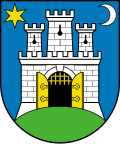Prior to 19th century
| History of Croatia |
|---|
 |
| Timeline |
- 1st century – Andautonia was founded
- 5th century – Andautonia was destroyed
- 1094 – Diocese of Zagreb established by Ladislaus I of Hungary; Cathedral construction begins (approximate date).[ citation needed ]
- 1242
- Gradec and Gornji Grad besieged by Tatars.
- Golden Bull issued by Béla IV of Hungary; Gradec becomes a royal free city.
- 1261 – Gradec fortification walls constructed.
- 1368 – Population: 2,810.
- 1476 – Works begin on Kaptol fortification in August. Bishop Osvald of Zagreb Diocese permits residence of laypeople in Kaptol for defense purposes, leading to resistance among clergy. [1]
- 1479 – Kaptol fortification walls completed. [2]
- 1557 – Croatian Parliament convenes at Gradec.
- 1573 – Matija Gubec, leader of the failed Croatian–Slovene peasant revolt, is executed.
- 1607
- Jesuit high school founded.
- National library founded.[ citation needed ]
- 1621 – Zagreb designated seat of Ban of Croatia.
- 1631 - Building of the students' seminary completed [3]
- 1632 – St. Catherine's Church built.
- 1647 – Foundation directed towards financing poor students from Croatian regions, Frangepaneum, established by Nikola IX Frankopan [4]
- 1651 – Catastrophic flood of Medveščak stream in July destroys all houses in Tkalčićeva Street. 52 people drown. [1]
- 1662 – Zrinski palace built [5]
- 1669 – Jesuit Academy established.
- 1670 – Fran Krsto Frankopan, poet and conspirator, visits the city in order to secure support from the citizens during the Magnate conspiracy [6]
- 1695 – Pavao Ritter Vitezović starts writing and publishing pamphlets, poetic, historiographical works on Saint Mark's Square
- 1742 – Population: 5,600.
- 1757 – Tituš Brezovački, notable dramatist and poet is born
- 1758 - First Croatian arithmetics textbook Arithmetika Horvatzka, written by Mihalj Šilobod Bolšić, was published
- 1764 - Vojković palace built
- 1771 – Ephemerides Zagrabienses , the first Croatian newspaper, begins publication. [7]
- 1776 – Royal council relocates to Zagreb from Varaždin.
- 1785 – The first bridge over Sava river is built. [8]
- 1786 – A large fire sweeps through Gradec, Kaptol and Tkalčićeva Street. [1]
- 1794
- Maksimir Park opens to the public
- Construction begins on foundation hospital on Harmica square (today's Ban Jelačić Square) [9]
- 1797 – Amadeo's theatre founded. [10]
